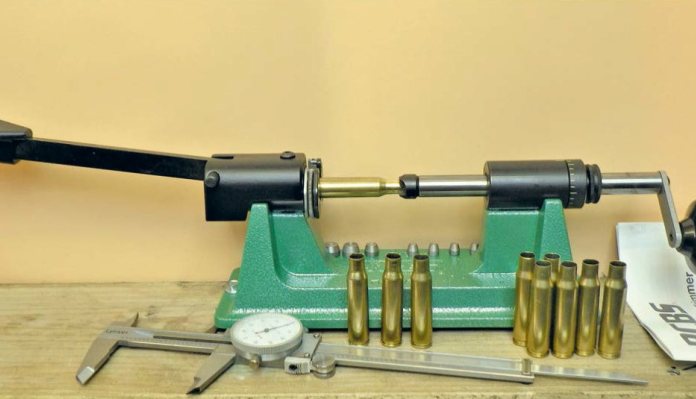Reloading Basics - Cases
- Last updated: 22/06/2022

The brass cases used in reloading are the only reusable component. This is because they are malleable and can be resized and reshaped. In all of the more common calibres, it is necessary to trim brass because the case gets longer as the brass flows forwards and will end up too long to correctly chamber in the rifle. It will also affect how the case is worked in the reloading dies and how it grips the bullet. The brass is never going to get so long that it jams against the lands in the bore, but it can get so long that it touches against the very front of the chamber.
If you do not keep your case length under control, you may eventually end up with the case neck so long that it creates reloading problems and, as the brass at the front edge of the case mouth thins, it will eventually crack and the case is done. You will also find that your reloads perform inconsistently.
Trimming the case back to a standard length gives the necessary clearance in the chamber and ensures that your rounds reload consistently. The standard length that brass is taken down to is called the ‘trim length’ and SAAMI and case manufacturers, like Lapua and Norma, all publish recommended trim lengths on their websites for specific calibres. These are the most reliable source of this information. Alternatively, you can trim all of your cases to the length of the shortest fired case in a batch. When you are inspecting your cases for cracks or damage, it is a convenient opportunity to measure a selection and find the shortest case, then trim the rest to that length.
Some manuals recommend trimming the cases to a dimension 0.001” shorter than the SAAMI specification and the trimmers that have an adjustable cutting length allow you to do this. You should also remember to trim any new, unfired brass to this same dimension before you load it, to keep things consistent.
How often you need to trim your brass depends on how ‘hot’ your loads are. The hotter they are the more likely your cases will stretch during firing. If you use a powder charge that is nearer to the start load shown in the reloading manual that you are using, then the amount that your brass stretches will be less. Standard .38 special loads used in .357 cases seem to cause no stretching of the brass at all and they never require trimming. Full magnum loads in those same cases will cause stretching each time they are used and so trimming is required much more often and case life is a lot shorter. .308 Winchester cases tend to need trimming after a couple of uses but the amount of stretching is minimal with standard loads.
When you resize your cases, particularly when the case is being drawn out of the full– length resizing die, the pressure applied can stretch the brass. For this reason, it is always best to check and trim your cases after they have been resized.
Lee Precision, Lyman, RCBS and other companies all make case trimmers. Some are electrically powered, some are powdered by a separate power tool and others are hand-operated. Some are micrometre adjustable and many come with calibrespecific pilots that help hold the case in place to ensure a squarely trimmed case mouth.
The simplest trimmers have calibre-specific case length gauges to ensure that all cases are trimmed to the corresponding SAAMI dimension. With other tools, you can decide the case length yourself and set the dimension with micrometre adjustment. Once set, all it takes is a few turns of the crank and your case is trimmed to length.
For a small number of cases, the Lee Precision Cutter and Lock Stud with the appropriate case length gauge allows you to trim them by hand to SAAMI dimensions. For a bit more speed they also make several models of their Quick Trim tool. This works on-press with calibrespecific dies, rather than in the hand, and you can add a power adaptor to really speed things up.
Alternatively, RCBS make some excellent bench-mounted case trimmers, like their Trim Pro 2, that you set to the desired length and then hand-crank to trim each case. These wellbuilt units have a universal shell holder and come with a set of pilots to fit a range of calibres. Once set up, with both fine and coarse adjustment to an accuracy of 0.001”, this type of tool is quick and easy to use.
After you have trimmed your cases, it is important to chamfer and deburr the case mouths. Chamfering the inside of the mouth improves bullet seating and deburring the outside ensures there are no rough edges to snag in the dies or in the gun’s chamber. In extreme cases, a burr on the inside of the case mouth can damage a bullet during seating or wedge between case and bullet causing damage to both and pressure issues as well.
The flow of brass forwards in a case, as it is fired each time, will usually be the cause of its eventual demise, but adequate trimming of the excess will help delay the end of its life. Trimming the thin front edge of the case mouth back to thicker brass reduces the chances of a crack starting at this point, plus reduces the likelihood of damaging the edge during reloading. Once trimmed to the same length all of your cases will engage with the reloading dies in exactly the same way and, when it is seated, they will all grip the bullet in the same way. All of this adds up to improved consistency and better results on the target.
Lee Reloading Equipment – Henry Krank & Co - www.henrykranks.com
RCBS – GMK Ltd - www.gmk.co.uk
Lyman – Hannan’s Reloading - www.hannamsreloading.com